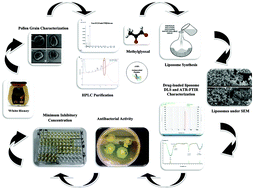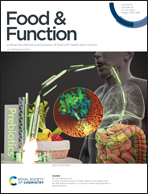Multifloral white honey outclasses manuka honey in methylglyoxal content: assessment of free and encapsulated methylglyoxal and anti-microbial peptides in liposomal formulation against toxigenic potential of Bacillus subtilis Subsp spizizenii strain†
Abstract
The therapeutic virtues of honey no longer need to be proven. Honey, which is rich in nutrients, is an excellent nutritional food because of its many properties; however, honey has been diverted from this primary function and used in clinical research. Evidence has shown that honey still possesses unknown properties and some of these aspects have never been addressed. In this work, two bioactive compounds found in honey (methylglyoxal and antimicrobial peptides) were evaluated for their anti-Bacillus subtilis activity with particular attention to their dilution factor. Although this bacterial strain does not possess an indigenous virulence factor gene, it becomes virulent by transferring plasmids with B. thuringiensis or expression of toxins from Bordetella pertussis. As is known, methylglyoxal is a toxic electrophile present in many eukaryotic and prokaryotic cells, which is generated by enzymatic and non-enzymatic reactions. Its overexpression successfully kills bacteria by inducing membrane disruption. Also, AMPs show potent inhibitory action against Gram-positive bacteria. Because of the lack of information concerning the main ingredients of honey, the microencapsulation process was used. Both methylglyoxal (MGO) and peptide-loaded liposomes were synthesized, characterized and compared to their free forms. The liposomal formulations contained a mixture of eggPC, cholesterol, and octadecylamine and their particle sizes were measured and their encapsulation efficacy calculated. The results revealed that Algerian multifloral white honey contained higher levels of MGO compared to manuka honey, which prevented bacterial growth and free MGO was relatively less effective. In fact, MGO killed BS in the loaded form with the same bacteriostatic and bactericidal index. However, the action of AMPs was different. Indeed, the investigation into the reactivity of MGO in the solvent indicated that regardless of the level of water added, honey is active at a fixed dilution. This data introduces the notion of dilution and abolishes the concept of concentration. Moreover, the synergistic antibacterial effect of the compounds in honey was diminished by the matrix effect. The degree of liposome-bacteria-fusion and the delay effect observed could be explain by both the composition and nature of the lipids used. Finally, this study reinforces the idea that under certain conditions, the metalloproteinases in honey produce AMPs.



 Please wait while we load your content...
Please wait while we load your content...